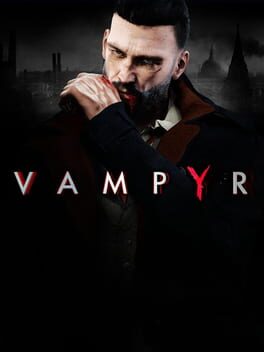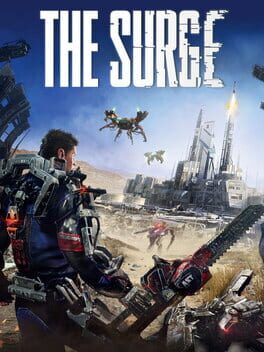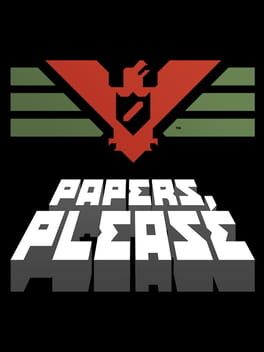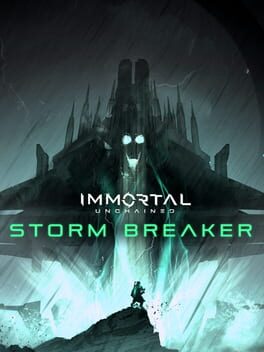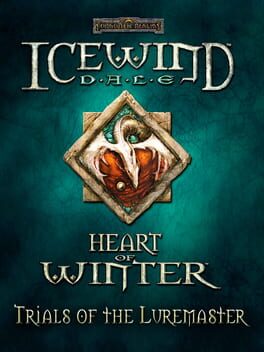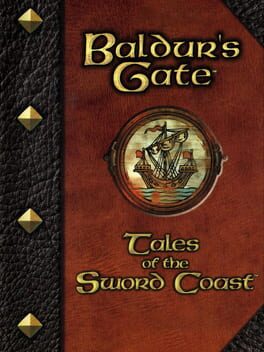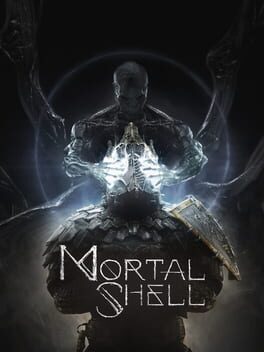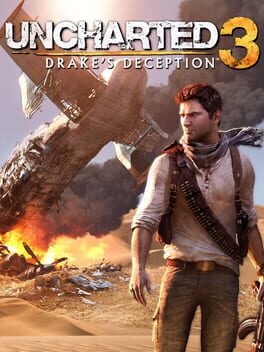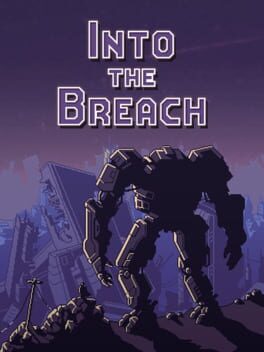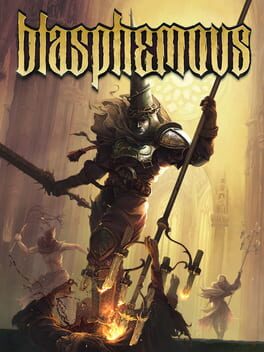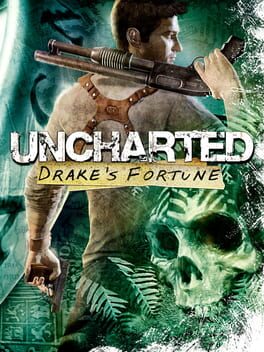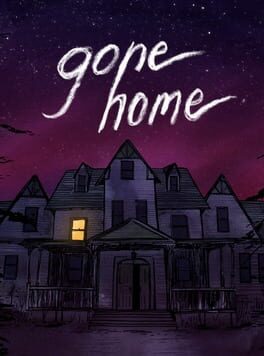squid0812
BACKER
2018
Vampyr is an intriguing if unpolished vampire RPG where the primary draw is building relationships with the many citizens (there are over 60) of London, before deciding whether you want to murder them and drink their blood for XP. All against the backdrop of the flu-ridden England of 1918 (a very cool setting that unfortunately gets a bit fatiguing, considering 3 out of 4 regions in the game are slums with few distinguishing characteristics).
Alas, it’s a cool concept that doesn’t really mesh with the storyline. In fact, the story ended up being my main problem with this game - it’s a clunky and generic tale of ancient evil and tainted blood (vampire story staples) that features a romance subplot which is very tacked-on and out of left field. Interacting with the citizens almost seems like it is part of a different game, so little does it have to do with overarching plot. Which is too bad, because interacting with the citizens is a lot of fun. You can use a variety of means to find out their backstories, which are occasionally rote but more frequently are pleasantly surprising. Almost all of the quality storytelling in this game is in the character work, not the main storyline. And the mechanic of having to choose whether you will get more powerful by killing off citizens or try to help stabilize the city by healing the sick is a fantastic role playing concept.
The last major element of the gameplay is the combat, a very light take on the standard Souls style that has a rubbed a lot of people the wrong way. I actually rather liked the way it felt, however. The main issue for me ended up being fatigue due to a lack of enemy variety. You spend most of the game fighting feral quasi-vampires called Skals or standard human guards. They are a few variants of each, but I felt like I had seen all the game had to offer enemy-wise from a very early point.
On the whole, this is a very flawed game that is built on some very interesting ideas. A more refined follow-up would have the potential for greatness.
Alas, it’s a cool concept that doesn’t really mesh with the storyline. In fact, the story ended up being my main problem with this game - it’s a clunky and generic tale of ancient evil and tainted blood (vampire story staples) that features a romance subplot which is very tacked-on and out of left field. Interacting with the citizens almost seems like it is part of a different game, so little does it have to do with overarching plot. Which is too bad, because interacting with the citizens is a lot of fun. You can use a variety of means to find out their backstories, which are occasionally rote but more frequently are pleasantly surprising. Almost all of the quality storytelling in this game is in the character work, not the main storyline. And the mechanic of having to choose whether you will get more powerful by killing off citizens or try to help stabilize the city by healing the sick is a fantastic role playing concept.
The last major element of the gameplay is the combat, a very light take on the standard Souls style that has a rubbed a lot of people the wrong way. I actually rather liked the way it felt, however. The main issue for me ended up being fatigue due to a lack of enemy variety. You spend most of the game fighting feral quasi-vampires called Skals or standard human guards. They are a few variants of each, but I felt like I had seen all the game had to offer enemy-wise from a very early point.
On the whole, this is a very flawed game that is built on some very interesting ideas. A more refined follow-up would have the potential for greatness.
2017
The seed of a decent idea buried under a pile of aggressively mediocre design concepts. I actually sort of appreciated the slow, plodding combat, but as with most Deck13 games, the overall aesthetic is so insipid that any minor pleasures are largely drowned out.
The interesting yet unrefined idea at the heart of this game is the dismemberment mechanic. Your melee attacks can target specific body parts and you can cut off various appendages in order to get better weapons and / or armor. This is fun at first, but eventually it becomes easy to spam, and the game ultimately doesn't do enough to build in complexity or alleviate the redundancy of repeatedly facing down the same basic enemy types (80% of the enemies in this game fall into one of two tired archetypes - there's quick-light-armor-man and slow-heavy-weapon-man).
Minor mechanical amusements aside, the narrative and aesthetic choices are consistently dull and uninspired. The story takes an extremely weak swing at Souls-style obliqueness, but ultimately ends up being bog standard sci-fi claptrap - it features some cartoonishly irresponsible corporate barons and A.I. run amuck, along with a smorgasbord of other well-trodden clichés.
I might've been able to partially look past the hackneyed narrative if it weren't for the fact that the dire lack of imagination is also reflected in the level and environmental design. After a tolerable start in a post-apocalyptic junkyard, most of the rest of the game takes place in a bland and anonymous maze of generic tech hallways. There's a decent diversion in a corporate suite towards the end, but that simply didn't make up for the confusion, the boredom, and the abject lack of interesting things to see. Skipping ahead to the more playable sequel is advisable.
The interesting yet unrefined idea at the heart of this game is the dismemberment mechanic. Your melee attacks can target specific body parts and you can cut off various appendages in order to get better weapons and / or armor. This is fun at first, but eventually it becomes easy to spam, and the game ultimately doesn't do enough to build in complexity or alleviate the redundancy of repeatedly facing down the same basic enemy types (80% of the enemies in this game fall into one of two tired archetypes - there's quick-light-armor-man and slow-heavy-weapon-man).
Minor mechanical amusements aside, the narrative and aesthetic choices are consistently dull and uninspired. The story takes an extremely weak swing at Souls-style obliqueness, but ultimately ends up being bog standard sci-fi claptrap - it features some cartoonishly irresponsible corporate barons and A.I. run amuck, along with a smorgasbord of other well-trodden clichés.
I might've been able to partially look past the hackneyed narrative if it weren't for the fact that the dire lack of imagination is also reflected in the level and environmental design. After a tolerable start in a post-apocalyptic junkyard, most of the rest of the game takes place in a bland and anonymous maze of generic tech hallways. There's a decent diversion in a corporate suite towards the end, but that simply didn't make up for the confusion, the boredom, and the abject lack of interesting things to see. Skipping ahead to the more playable sequel is advisable.
1998
Something of a quantum leap forward for the Resident Evil series. The RPD may lack the iconic reputation of the Spencer Mansion from the original game, but in every other aspect - level design, scope, environmental detail - it’s a significant upgrade.
This is also a much more cinematic experience - it keeps the campy sense of schlock but ditches the cheap voice acting and FMV of the original game. Consequently, the set pieces are shockingly effective - from the first licker appearance, to Chief Irons giving his deranged villain speech with the dead body of the mayor’s daughter draped over his desk, to nearly every sequence involving Mr. X, RE2 really nails multiple shades of creepiness and tension in a way that’s rare for any game, let alone one from the PS1 era.
One way that this game didn’t really change from the original Resident Evil is in the gameplay - it’s still principally about solving a series of relatively simple puzzles, fighting off zombies and other monsters, and managing inventory slots as you explore a confined space. I openly acknowledge that tastes will vary here - some people really can’t stand the tank controls and fixed camera angles. I, for one, love the gameplay of early Resident Evil. Exploring a space that’s been stricken by catastrophe, improvising on the fly in order to conserve resources, blowing zombie heads clean off with sweet, sonorous shotgun blasts - all of these are gaming tropes that I am huge sucker for, and this game has them in spades.
Of course, some elements of this game haven’t aged well. The zapping system was meant to add a wrinkle to the inventory management as you played through the game with each character - but the choices it involves are so slight that the effect is barely noticeable. Add on the fact that many parts of the story make no sense if you choose to play Leon A / Claire B, and I’m inclined to label this system a dud. Also, the sequences in which the player controls a character other than Leon or Claire are annoying (if mercifully short) slogs.
Still, whatever its flaws, RE2 was where Resident Evil crossed the line from being an intriguing diversion to being one of my all-time favorite game franchises. Having replayed this fairly recently as a point of comparison with the (superb) remake, I can testify that this game holds up exceedingly well. Not to be missed.
This is also a much more cinematic experience - it keeps the campy sense of schlock but ditches the cheap voice acting and FMV of the original game. Consequently, the set pieces are shockingly effective - from the first licker appearance, to Chief Irons giving his deranged villain speech with the dead body of the mayor’s daughter draped over his desk, to nearly every sequence involving Mr. X, RE2 really nails multiple shades of creepiness and tension in a way that’s rare for any game, let alone one from the PS1 era.
One way that this game didn’t really change from the original Resident Evil is in the gameplay - it’s still principally about solving a series of relatively simple puzzles, fighting off zombies and other monsters, and managing inventory slots as you explore a confined space. I openly acknowledge that tastes will vary here - some people really can’t stand the tank controls and fixed camera angles. I, for one, love the gameplay of early Resident Evil. Exploring a space that’s been stricken by catastrophe, improvising on the fly in order to conserve resources, blowing zombie heads clean off with sweet, sonorous shotgun blasts - all of these are gaming tropes that I am huge sucker for, and this game has them in spades.
Of course, some elements of this game haven’t aged well. The zapping system was meant to add a wrinkle to the inventory management as you played through the game with each character - but the choices it involves are so slight that the effect is barely noticeable. Add on the fact that many parts of the story make no sense if you choose to play Leon A / Claire B, and I’m inclined to label this system a dud. Also, the sequences in which the player controls a character other than Leon or Claire are annoying (if mercifully short) slogs.
Still, whatever its flaws, RE2 was where Resident Evil crossed the line from being an intriguing diversion to being one of my all-time favorite game franchises. Having replayed this fairly recently as a point of comparison with the (superb) remake, I can testify that this game holds up exceedingly well. Not to be missed.
2013
Seemingly a simple game with limited scope that really sneaks up on you with its unique ability to repeatedly make you feel like a complete monster. This is a ‘message game’ par excellence, one that expertly manipulates the player into making heinous moral choices with the mere ‘ka-chunk’ of a customs stamp. You play as a border official in a fictionalized totalitarian state, navigating an ever-growing list of arcane rules as you attempt to correctly process heaps of paperwork. Mixing scripted events with procedurally generated border crossings, the moment-to-moment play is focused on management of the cluttered desk on which you have to shuffle about the numerous papers you’re checking. As you engage with this system more and more, the processing develops an almost hypnotic quality. Shifting different papers about, stamping passports, and calling in guards (among other things) all become second nature. Indeed, one of the most brilliant parts of this game is how subtle details in the sound design and the booth interface make these processes feel both satisfying and true to life.
Of course, from a thematic standpoint, all the paperwork is just a smokescreen. As you get into a rhythm of robotically and efficiently processing entries, the game starts to present you with increasingly complex and diverse moral dilemmas - a wife who is missing the paperwork required to accompany her husband, a human trafficker who has proper documentation but who will undoubtedly commit terrible crimes if admitted into the country, and so on. You can always choose to do the right thing, but it nearly always leads to significant, employer-imposed financial penalties (or sometimes the triggering of a fail state) for your character and their family. I was frequently taken aback by how this game lulled me into a state where the efficient operation of my repetitive one man assembly line took precedence over treating the people in the booth with humanity and respect. Which, of course, is the point. A frightening testament to how ethical landmines can be hidden within a bureaucratic swamp of paperwork and regulations, this is actually one of the most unsettling games I’ve played. I wouldn’t necessarily call it fun, but I would call it essential.
Of course, from a thematic standpoint, all the paperwork is just a smokescreen. As you get into a rhythm of robotically and efficiently processing entries, the game starts to present you with increasingly complex and diverse moral dilemmas - a wife who is missing the paperwork required to accompany her husband, a human trafficker who has proper documentation but who will undoubtedly commit terrible crimes if admitted into the country, and so on. You can always choose to do the right thing, but it nearly always leads to significant, employer-imposed financial penalties (or sometimes the triggering of a fail state) for your character and their family. I was frequently taken aback by how this game lulled me into a state where the efficient operation of my repetitive one man assembly line took precedence over treating the people in the booth with humanity and respect. Which, of course, is the point. A frightening testament to how ethical landmines can be hidden within a bureaucratic swamp of paperwork and regulations, this is actually one of the most unsettling games I’ve played. I wouldn’t necessarily call it fun, but I would call it essential.
For all its obvious flaws, the main campaign of Immortal: Unchained actually showed a good amount of promise in laying out a path forward for Souls-style shooters. Unfortunately, the DLC doubled down on some of the very worst gameplay elements from the main game. The whole experience is an overly hostile slog, jam-packed with enemies whose tankiness and damage output are extremely excessive (there is even one new enemy that literally can’t be killed unless you hit one specific, pixel-sized spot that is only occasionally exposed). It’s to the point where it feels like the only option is to either run or cheese your way through. Which doesn’t leave much time to take in the new levels - a shame, considering the dried out sea bed and sunken ships offer a fairly interesting new biome in a game full of generic tech hallways.
The final boss of the DLC is almost good, but suffers from two issues, one of which is basically unforgivable: the encounter starts with a very tough, wave-based fight against regular enemies that you have to repeat every time you try to kill the boss (in case it wasn’t clear, this is tedious and awful). Also, the boss himself is about 20% too fast for the game’s engine - I knew the moves and how to deal with them, but sometimes my guy simply didn’t move out of the way quickly enough. It’s deeply frustrating to have your avatar skill fail to match up with player skill.
Ultimately, this is a DLC that is discouraging more than anything else. The makers of I:U had some cool ideas about how to take Soulslike gameplay and meld it with third person shooter mechanics. Unfortunately, it appears with this DLC that the devs bought into the toxic, ‘git gud’, difficulty-fuck messaging that emanates from the worst corners of Souls fandom.
The final boss of the DLC is almost good, but suffers from two issues, one of which is basically unforgivable: the encounter starts with a very tough, wave-based fight against regular enemies that you have to repeat every time you try to kill the boss (in case it wasn’t clear, this is tedious and awful). Also, the boss himself is about 20% too fast for the game’s engine - I knew the moves and how to deal with them, but sometimes my guy simply didn’t move out of the way quickly enough. It’s deeply frustrating to have your avatar skill fail to match up with player skill.
Ultimately, this is a DLC that is discouraging more than anything else. The makers of I:U had some cool ideas about how to take Soulslike gameplay and meld it with third person shooter mechanics. Unfortunately, it appears with this DLC that the devs bought into the toxic, ‘git gud’, difficulty-fuck messaging that emanates from the worst corners of Souls fandom.
The rarest of breeds: an expansion-within-an-expansion. In the mythical days of yore when a 10-15 hour expansion was somehow considered too short, Black Isle Studios added this utterly extraneous mini-module onto Icewind Dale’s Heart of Winter expansion as a mea culpa. As previously implied, this has literally nothing to do with the narrative of the aforementioned expansion or the base game - instead, your party is unceremoniously and involuntarily teleported to a fort in the middle of the desert to be ‘tested’ by the titular villain. Despite the jarringly disconnected nature of the premise, this isn’t without some minor successes. The dungeon design, as in most of Icewind Dale, is largely quite strong. In fact, the addition of some elementary puzzles, mostly absent in the main game, feels like a straight-up improvement. For roughly the first third or so, the enemy mobs feel appropriately (rather than relentlessly) challenging.
Sadly, this gentle difficulty curve doesn’t last. Once you enter the main keep, the game reverts back to attrition mode. The latter parts of this expansion are even more unforgiving than the hardest parts of the main game. It feels like there is an enemy encounter designed to push your party to its breaking point every two minutes. I respect and even enjoy the crunchiness of 2nd Edition D and D, but when it’s this unrelenting, I just get exhausted. Mercifully, the actual Luremaster himself is a fairly straightforward final boss. The grind to reach him is borderline-intolerable, though.
Sadly, this gentle difficulty curve doesn’t last. Once you enter the main keep, the game reverts back to attrition mode. The latter parts of this expansion are even more unforgiving than the hardest parts of the main game. It feels like there is an enemy encounter designed to push your party to its breaking point every two minutes. I respect and even enjoy the crunchiness of 2nd Edition D and D, but when it’s this unrelenting, I just get exhausted. Mercifully, the actual Luremaster himself is a fairly straightforward final boss. The grind to reach him is borderline-intolerable, though.
The island of werewolves (or is it wolfweres?) is simply a few extra maps of standard Baldur's Gate side questing - which is to say it's enjoyable and worth your time without being especially revelatory.
The addition that makes this expansion truly stand out, though, is Durlag's Tower, which is arguably still the greatest prestige dungeon that BioWare has ever created, even after Baldur's Gate II and a bevy of Dragon Age and Mass Effect games. Six floors jam-packed with challenging monster encounters, thought-provoking puzzles, and plenty of evocative details and creepy atmospherics, the Tower acts as both a final exam for players to test their mastery of 2nd Edition mechanics and as an thrilling harbinger of the kind of rich and engaging side stories that are all over the place in Baldur's Gate II.
You won't lose much if you skip the Werewolf Island, but Durlag's Tower is not be missed.
The addition that makes this expansion truly stand out, though, is Durlag's Tower, which is arguably still the greatest prestige dungeon that BioWare has ever created, even after Baldur's Gate II and a bevy of Dragon Age and Mass Effect games. Six floors jam-packed with challenging monster encounters, thought-provoking puzzles, and plenty of evocative details and creepy atmospherics, the Tower acts as both a final exam for players to test their mastery of 2nd Edition mechanics and as an thrilling harbinger of the kind of rich and engaging side stories that are all over the place in Baldur's Gate II.
You won't lose much if you skip the Werewolf Island, but Durlag's Tower is not be missed.
2020
Neat if unspectacular. A short, breezy entry into the ever-expanding Souls-like genre, this game is pretty fun in spite of feeling a bit like consuming empty calories in certain ways. The level design is complex, but unnecessarily so in many cases (what is up with all of the crawlspaces that bring you to places you likely already discovered by simply walking along a path?) The plot is an extremely stock-standard re-take of Dark Souls post-Lordvessel acquisition - kill some demigods, bring back their essences to a giant, vaguely ominous animal creature, fight the final boss, ascend to a highly compromised form of godhood, etc. Along the way, you'll find the elliptical, ambiguous lore notes that we've come to expect from these stories, but as with most non-From games in this genre, these are dull and ponderous rather than intriguing or mordantly humorous.
So why do I still kind of like this game despite thinking the story is basically complete trash? Well, the gameplay, of course! This game feels great in the hands. Most of what I enjoy in the combat is rooted in the 'hardness' mechanic, one of the cooler twists on Soulslike combat that I've seen. Your character can harden to avoid damage, but you can also get creative by hardening while attacking, hardening to nullify status effects, and so on. It's an unexpectedly deep mechanic that contributes to making the combat a lot of fun. There is also a charming simplicity to the enemy movesets that reminded me of early From games like Demon's Souls - every enemy (including most bosses) has at most 3-4 moves, and each is clearly telegraphed with plenty of time to respond. This is not the twitchy, reflex-based combat of Bloodborne or Dark Souls III, but rather the stodgier, more methodical combat of Demon's Souls or Dark Souls. That may disappoint some, but I like both. Slow and methodical is rarer these days, so I was pleasantly surprised. Overall, a fun if minor game that feels a bit like a proof-of-concept project that From might have made in 2008.
So why do I still kind of like this game despite thinking the story is basically complete trash? Well, the gameplay, of course! This game feels great in the hands. Most of what I enjoy in the combat is rooted in the 'hardness' mechanic, one of the cooler twists on Soulslike combat that I've seen. Your character can harden to avoid damage, but you can also get creative by hardening while attacking, hardening to nullify status effects, and so on. It's an unexpectedly deep mechanic that contributes to making the combat a lot of fun. There is also a charming simplicity to the enemy movesets that reminded me of early From games like Demon's Souls - every enemy (including most bosses) has at most 3-4 moves, and each is clearly telegraphed with plenty of time to respond. This is not the twitchy, reflex-based combat of Bloodborne or Dark Souls III, but rather the stodgier, more methodical combat of Demon's Souls or Dark Souls. That may disappoint some, but I like both. Slow and methodical is rarer these days, so I was pleasantly surprised. Overall, a fun if minor game that feels a bit like a proof-of-concept project that From might have made in 2008.
A classic example of an old dictum: trying to recapture lightning in a bottle is a fool's errand that only results in a less inspired piece of art. Fresh off the success of Uncharted 2, Naughty Dog clearly took a long look at their template for that game and came away with a series of pretty juvenile conclusions. Bigger set pieces, more exotic locales, more shooting - that was the way forward to even more triumphant success.
The problem is that they neglected a lot of the stuff that actually made the second game stand out - namely, the spot-on pacing (torpedoed here by a bloated opening act that features extended visits to not one, but two mostly extraneous locations to collect some pointless MacGuffins) and punchy banter that made it feel like you were starring in a modern-day Flash Gordon serial (still here, though less consistently; I personally could have done without the entire flashback subplot where Sully deals with Nate's daddy abandonment issues).
What results is a game whose primary sin is being eminently forgettable. It's not a gameplay issue. The act of playing this is largely similar to any other Uncharted - the bland and tiresome combat is counterbalanced with puzzles that are usually fine but are also rather repetitive. But the actual problem is that the real things that drive people play these games feel so thoroughly uninspired. There are a few exciting bits, a few wisecracks that may make provoke a chuckle or two. But there's absolutely nothing here that didn't immediately leave my brain always and forever as soon as the credits rolled. I enjoy my frivolous diversions just as much as the next person. But empty calories have rarely felt any emptier.
The problem is that they neglected a lot of the stuff that actually made the second game stand out - namely, the spot-on pacing (torpedoed here by a bloated opening act that features extended visits to not one, but two mostly extraneous locations to collect some pointless MacGuffins) and punchy banter that made it feel like you were starring in a modern-day Flash Gordon serial (still here, though less consistently; I personally could have done without the entire flashback subplot where Sully deals with Nate's daddy abandonment issues).
What results is a game whose primary sin is being eminently forgettable. It's not a gameplay issue. The act of playing this is largely similar to any other Uncharted - the bland and tiresome combat is counterbalanced with puzzles that are usually fine but are also rather repetitive. But the actual problem is that the real things that drive people play these games feel so thoroughly uninspired. There are a few exciting bits, a few wisecracks that may make provoke a chuckle or two. But there's absolutely nothing here that didn't immediately leave my brain always and forever as soon as the credits rolled. I enjoy my frivolous diversions just as much as the next person. But empty calories have rarely felt any emptier.
2018
I should start by clarifying that I think that Into the Breach is more or less a flawless game. I docked this one star for purely personal reasons - namely, that puzzle-based strategy games like these generally don’t mesh with my tastes. I have immense respect for this game’s design, yet I can’t quite find it in me to love it. Thus I ended up as a person who played this for 25-30 hours and moved on instead of one of the numerous people I’ve seen online who continue to put in hundreds or even thousands of hours.
The general hook is fine enough (especially true if you are more into mechs and / or kaiju than I am): you guide a team of mechs in grid-based battles against giant alien bugs called Vek. As with the best strategy puzzlers, what at first seems simple is in fact deceptively complex. The degree of complexity is deep without being over-complicated or obtuse. Most impressive of all, much of the game’s complexity is determined by player opt-in. There’s the typical choice of difficulty level, sure, but you can also choose to proceed to the final fight having beaten only two of the game’s four islands (having trouble with the Ice Island?? Being stuck doesn’t mean that you can’t still beat the game). As you play more, you can also unlock different mech squads, with varying levels of difficulty based on the squad’s abilities. I find the base squad well-balanced and appropriately challenging to play with, but those looking to pilot a different strategy (i.e. damage over time, using movement abilities, inflicting status effects, etc.) will have plenty of options. You will also progressively unlock new mech pilots who have unique perks throughout the game. Some perks, like the ability to move after firing on an enemy, are straight-up overpowered, while others are more specialized. Choosing islands, mech squads, pilots, and upgrades makes for an very impressive array of interesting decisions for each run-through. It also makes for a game that has probably the best example of player-selected difficulty that I know of. When I just wanted a quick, relaxing run, I would choose my preferred mech squad, the best available pilots, and probably finish out with the final fight after only two islands. On the other hand, when I wanted a challenge, I could test out a newer squad, take some of the harder-to-use pilots, and try play through all four islands before the finale. The degree to which the game allows you make it quick and breezy or punishing and tense depending on player preference is genuinely outstanding.
I know I’ve talked a lot about difficulty - logically enough, that’s because this game is hard. Thankfully, it’s hard in a satisfying way. This is a game that will force you to make sacrifices to achieve your goal. You will run into situations (especially on higher difficulties), where you will be forced to put your best pilot in the path of a killing blow in order to save the mission. This can produce a lot of tension, but it never became frustrating for me. I think the key to this is that the game gives you perfect knowledge of what the enemy will do on their next move. Now, this might seem like an unfair advantage for the player - it is the rough equivalent of knowing what your opponent’s next move will be in chess, after all. But having this information is actually necessary for the game to work, because the enemy is stronger than you. The Vek have more units, more movement capabilities, and sometimes more health or damage capability than the mechs - the only way make these advantages not seem totally unfair is to offer the player clear information about what they will do next. It ends up working so well - again, I can’t really overstate the sense of tension that this game generates without ever tipping over into frustration.
Puzzlers and strategy are not my thing. Doubly true for mechs and kaiju. But Into the Breach’s beautifully tuned mechanics ultimately made me toss aside my reservations. It’s a hell of a game, one that even a skeptic like me can’t help but recommend.
The general hook is fine enough (especially true if you are more into mechs and / or kaiju than I am): you guide a team of mechs in grid-based battles against giant alien bugs called Vek. As with the best strategy puzzlers, what at first seems simple is in fact deceptively complex. The degree of complexity is deep without being over-complicated or obtuse. Most impressive of all, much of the game’s complexity is determined by player opt-in. There’s the typical choice of difficulty level, sure, but you can also choose to proceed to the final fight having beaten only two of the game’s four islands (having trouble with the Ice Island?? Being stuck doesn’t mean that you can’t still beat the game). As you play more, you can also unlock different mech squads, with varying levels of difficulty based on the squad’s abilities. I find the base squad well-balanced and appropriately challenging to play with, but those looking to pilot a different strategy (i.e. damage over time, using movement abilities, inflicting status effects, etc.) will have plenty of options. You will also progressively unlock new mech pilots who have unique perks throughout the game. Some perks, like the ability to move after firing on an enemy, are straight-up overpowered, while others are more specialized. Choosing islands, mech squads, pilots, and upgrades makes for an very impressive array of interesting decisions for each run-through. It also makes for a game that has probably the best example of player-selected difficulty that I know of. When I just wanted a quick, relaxing run, I would choose my preferred mech squad, the best available pilots, and probably finish out with the final fight after only two islands. On the other hand, when I wanted a challenge, I could test out a newer squad, take some of the harder-to-use pilots, and try play through all four islands before the finale. The degree to which the game allows you make it quick and breezy or punishing and tense depending on player preference is genuinely outstanding.
I know I’ve talked a lot about difficulty - logically enough, that’s because this game is hard. Thankfully, it’s hard in a satisfying way. This is a game that will force you to make sacrifices to achieve your goal. You will run into situations (especially on higher difficulties), where you will be forced to put your best pilot in the path of a killing blow in order to save the mission. This can produce a lot of tension, but it never became frustrating for me. I think the key to this is that the game gives you perfect knowledge of what the enemy will do on their next move. Now, this might seem like an unfair advantage for the player - it is the rough equivalent of knowing what your opponent’s next move will be in chess, after all. But having this information is actually necessary for the game to work, because the enemy is stronger than you. The Vek have more units, more movement capabilities, and sometimes more health or damage capability than the mechs - the only way make these advantages not seem totally unfair is to offer the player clear information about what they will do next. It ends up working so well - again, I can’t really overstate the sense of tension that this game generates without ever tipping over into frustration.
Puzzlers and strategy are not my thing. Doubly true for mechs and kaiju. But Into the Breach’s beautifully tuned mechanics ultimately made me toss aside my reservations. It’s a hell of a game, one that even a skeptic like me can’t help but recommend.
2019
A flawed game with one particular aspect that stands out as S-tier: the astounding pixel art, which is possibly the best I’ve ever encountered in games. Whatever type of imagery you prefer, this game has it: the creepy, the surreal, the ineffable. A giant, blindfolded baby with bleeding eyes. A floating head pockmarked with scars and exposed brain matter. These are just a few of the more jaw-dropping examples in a game that is full of this kind of stuff. Even if this isn’t your type of game, you owe it to yourself to check out some screenshots - it really is that good.
Alas, every other part of the game registered as just OK for me. The combat is fun enough, but it’s also rather simplistic. Nearly everything that isn’t a standard attack, dodge, or parry feels tangential or only situationally useful. The various Metroidvania upgrades are all exploration-based and thus never play a role in combat as sometimes happens in other games of this ilk (i.e. Hollow Knight). Fundamentally, the combat moveset at the beginning of the game is very similar to the moveset at the end. It’s fine, there’s just not a lot of movement.
I feel similarly ambivalent about the platforming and exploration. I love the way the dodge feels in this game, but the jumping always felt a bit off for reasons I can’t describe. It didn’t happen a lot, but there were definitely times when I missed a jump or mantle that I felt like I should’ve had. Normally, I wouldn’t consider this a big deal, but when instant death spikes are in play (why?), even trivial amounts of platforming jank are unacceptable. Most of the really tough platforming is in optional areas, so at least there’s that. Speaking of which, there are plenty of cool, optional secrets here - illusory walls and riddles abound. Unfortunately, a lot of what you find are meaningless Kickstarter collectibles - this game sort of has a desperate need for more useful items that give you a reason to fully explore its world. It doesn’t help that your character never picks up any movement upgrades - I kept hoping to pick up a double jump or air dash that would make it more fun on a moment-to-moment basis to backtrack and scout out the map for secrets.
The stellar imagery and oppressive mood were enough to keep me going here - but a follow-up with some gameplay and story refinements (more direct storytelling and a little less figurative / lyrical mumbo-jumbo might help the plot stick a bit more) has the potential for greatness.
Alas, every other part of the game registered as just OK for me. The combat is fun enough, but it’s also rather simplistic. Nearly everything that isn’t a standard attack, dodge, or parry feels tangential or only situationally useful. The various Metroidvania upgrades are all exploration-based and thus never play a role in combat as sometimes happens in other games of this ilk (i.e. Hollow Knight). Fundamentally, the combat moveset at the beginning of the game is very similar to the moveset at the end. It’s fine, there’s just not a lot of movement.
I feel similarly ambivalent about the platforming and exploration. I love the way the dodge feels in this game, but the jumping always felt a bit off for reasons I can’t describe. It didn’t happen a lot, but there were definitely times when I missed a jump or mantle that I felt like I should’ve had. Normally, I wouldn’t consider this a big deal, but when instant death spikes are in play (why?), even trivial amounts of platforming jank are unacceptable. Most of the really tough platforming is in optional areas, so at least there’s that. Speaking of which, there are plenty of cool, optional secrets here - illusory walls and riddles abound. Unfortunately, a lot of what you find are meaningless Kickstarter collectibles - this game sort of has a desperate need for more useful items that give you a reason to fully explore its world. It doesn’t help that your character never picks up any movement upgrades - I kept hoping to pick up a double jump or air dash that would make it more fun on a moment-to-moment basis to backtrack and scout out the map for secrets.
The stellar imagery and oppressive mood were enough to keep me going here - but a follow-up with some gameplay and story refinements (more direct storytelling and a little less figurative / lyrical mumbo-jumbo might help the plot stick a bit more) has the potential for greatness.
This review contains spoilers
None of the Uncharted games (including 4, which is relatively new) have aged particularly well, but the first entry in the series takes the cake in terms of being borderline unplayable in 2021. The charming interplay between genuinely likeable characters has always been the main draw of the series, and it’s present here as well, but everything else about this is really tough to swallow. The shooting is already bad enough, but the fact that enemies are massive bullet sponges (granted, also a problem in 2 and 3) makes every fight an interminable slog. The setting looks good for a game of this vintage, but it’s also effectively a hallway almost completely lacking in side paths and nooks that we would see in the later games.
The set pieces, so often the highlight of Uncharted games, are a mixed bag here - the bit with the U-boat stuck deep in the jungle, for instance, is a cool idea that is marred by the incredibly dumb and obvious fake death of Sully. The prison escape with Elena, in which you fight off pursuing vehicles with a machine gun mounted to the back of a jeep, is probably the best story beat and the game’s only successful gameplay switch away from the horrid third person shooting. But that small success is counterbalanced by the jet ski sequences, which are so awful that it’s unfathomable that they even made it into the game.
The story, which is a major strength in later games, is a fairly standard ripoff of Raiders of the Lost Ark, right down to the Nazis mutated by a cursed artifact. Still, the banter and chemistry between Nathan, Sully, and Elena is enjoyable, and the bumbling Eddie Raja is pretty amusing as one of villains. Stay around for the cutscenes, but don’t expect much from the gameplay until the sequels.
The set pieces, so often the highlight of Uncharted games, are a mixed bag here - the bit with the U-boat stuck deep in the jungle, for instance, is a cool idea that is marred by the incredibly dumb and obvious fake death of Sully. The prison escape with Elena, in which you fight off pursuing vehicles with a machine gun mounted to the back of a jeep, is probably the best story beat and the game’s only successful gameplay switch away from the horrid third person shooting. But that small success is counterbalanced by the jet ski sequences, which are so awful that it’s unfathomable that they even made it into the game.
The story, which is a major strength in later games, is a fairly standard ripoff of Raiders of the Lost Ark, right down to the Nazis mutated by a cursed artifact. Still, the banter and chemistry between Nathan, Sully, and Elena is enjoyable, and the bumbling Eddie Raja is pretty amusing as one of villains. Stay around for the cutscenes, but don’t expect much from the gameplay until the sequels.
2012
This review contains spoilers
Includes spoilers
Mass Effect 3, for all the ink that’s been spilled on it, remains a unique experience in 2021. Once justly derided for its ending, this game now functions as a sort of Rorschach test for how people feel about the series as a whole. This is a game that bizarrely includes some of the most genuinely moving and emotionally resonant moments you will ever experience in any video game (assuming you play 1+2 beforehand, at least) alongside moments of equally staggering stupidity (looking at you, Kai Leng). When this game works, it’s absolutely unforgettable. By the same token, when it’s at its worst, it’s incredibly frustrating.
Starting off with the positive - the Tuchanka and Rannoch storylines in this game are just so unbelievably satisfying and moving. The writers beautifully leverage characters and plot elements from the first two games to bring long-running arcs to their crescendos. I just can’t really imagine a person who played ME1 and 2 and isn’t just completely gutted by what happens to Mordin and / or Wrex in the Tuchanka storyline and to Tali in the Rannoch storyline. Even Legion, who really only made a cameo in the last 10% of ME2, gets a memorable resolution here that is full of well-earned pathos.
Indeed, interaction with companions is one of the major overall wins of ME3 - longtime stalwarts like Garrus and Liara also feel much more fleshed out and real. Pretty much all of the more brief interactions you have with former companions from previous games are spot-on, beautifully balancing nostalgia with the need to move the story forward (Grunt’s last stand is a standout). People justifiably rip on the ending of this game, but it’s also genuinely too bad that moments like the touching scene of saying goodbye to all of your teammates before the final battle or the shooting competition with Garrus in the Citadel got forgotten in the vitriol.
It’s unfortunate that the vitriol exists, but that doesn’t mean it’s not at least partially understandable. Yes, I think the ending is bad (even with the extended cut), but I would actually go further to say that basically anything involving Cerberus in this game is really dumb. I would love to know what jackass at BioWare thought it would be good idea to make one of the game’s main villains a generic space ninja (it was probably the same guy who thought up the equally stupid ‘human reaper’ as the final boss of ME2). The inanity of Kai Leng is a symptom of the larger issue, which is that the morally ambiguous conception of Cerberus from ME2 is thrown out the window, replaced by over-the-top mustache-twirling. This was the Illusive Man’s plan all along? Bumble his way into getting indoctrinated by the Reapers? Cerberus felt like they were building toward something cool in the second game - in ME3, it feels like they are only in the game so that there are humanoid enemy types available for multiplayer.
Which is another issue in and of itself - some of what makes Mass Effect games great was clearly sacrificed on the altar of multiplayer. Side questing and exploration, which were major parts of ME1 (and to a lesser degree, ME2) appear to be the big casualties of the multiplayer focus. Most of the side quests are reduced to simple planet scanning fetch quests that I would’ve rather had been left on the cutting room floor. The side quests that involve actual gameplay are just advertisements for the multiplayer (they take place in what are obviously multiplayer arenas).
Now for the elephant in the room - that ending. I agree that it’s not good. I do think people overstate the problem a bit, though. It is slight and underwhelming, to be sure. Also, I find the constant reminders of the kid who dies at the beginning to be really cheap and exploitative, a perfect example of an unearned emotional payoff. And yes, the choices are predictable, but ultimately I was OK with the outcome of the one I picked, even if I wasn’t particularly moved. Almost a decade on, I generally find the ending to be harmless and inoffensive. Weak praise, I know, but certainly more kind than most people were at launch.
ME3 is a fun game that hits some extremely satisfying high points while also frequently frustrating and annoying me. Still, if you’re a fan of the series, there’s no way you can miss this.
Mass Effect 3, for all the ink that’s been spilled on it, remains a unique experience in 2021. Once justly derided for its ending, this game now functions as a sort of Rorschach test for how people feel about the series as a whole. This is a game that bizarrely includes some of the most genuinely moving and emotionally resonant moments you will ever experience in any video game (assuming you play 1+2 beforehand, at least) alongside moments of equally staggering stupidity (looking at you, Kai Leng). When this game works, it’s absolutely unforgettable. By the same token, when it’s at its worst, it’s incredibly frustrating.
Starting off with the positive - the Tuchanka and Rannoch storylines in this game are just so unbelievably satisfying and moving. The writers beautifully leverage characters and plot elements from the first two games to bring long-running arcs to their crescendos. I just can’t really imagine a person who played ME1 and 2 and isn’t just completely gutted by what happens to Mordin and / or Wrex in the Tuchanka storyline and to Tali in the Rannoch storyline. Even Legion, who really only made a cameo in the last 10% of ME2, gets a memorable resolution here that is full of well-earned pathos.
Indeed, interaction with companions is one of the major overall wins of ME3 - longtime stalwarts like Garrus and Liara also feel much more fleshed out and real. Pretty much all of the more brief interactions you have with former companions from previous games are spot-on, beautifully balancing nostalgia with the need to move the story forward (Grunt’s last stand is a standout). People justifiably rip on the ending of this game, but it’s also genuinely too bad that moments like the touching scene of saying goodbye to all of your teammates before the final battle or the shooting competition with Garrus in the Citadel got forgotten in the vitriol.
It’s unfortunate that the vitriol exists, but that doesn’t mean it’s not at least partially understandable. Yes, I think the ending is bad (even with the extended cut), but I would actually go further to say that basically anything involving Cerberus in this game is really dumb. I would love to know what jackass at BioWare thought it would be good idea to make one of the game’s main villains a generic space ninja (it was probably the same guy who thought up the equally stupid ‘human reaper’ as the final boss of ME2). The inanity of Kai Leng is a symptom of the larger issue, which is that the morally ambiguous conception of Cerberus from ME2 is thrown out the window, replaced by over-the-top mustache-twirling. This was the Illusive Man’s plan all along? Bumble his way into getting indoctrinated by the Reapers? Cerberus felt like they were building toward something cool in the second game - in ME3, it feels like they are only in the game so that there are humanoid enemy types available for multiplayer.
Which is another issue in and of itself - some of what makes Mass Effect games great was clearly sacrificed on the altar of multiplayer. Side questing and exploration, which were major parts of ME1 (and to a lesser degree, ME2) appear to be the big casualties of the multiplayer focus. Most of the side quests are reduced to simple planet scanning fetch quests that I would’ve rather had been left on the cutting room floor. The side quests that involve actual gameplay are just advertisements for the multiplayer (they take place in what are obviously multiplayer arenas).
Now for the elephant in the room - that ending. I agree that it’s not good. I do think people overstate the problem a bit, though. It is slight and underwhelming, to be sure. Also, I find the constant reminders of the kid who dies at the beginning to be really cheap and exploitative, a perfect example of an unearned emotional payoff. And yes, the choices are predictable, but ultimately I was OK with the outcome of the one I picked, even if I wasn’t particularly moved. Almost a decade on, I generally find the ending to be harmless and inoffensive. Weak praise, I know, but certainly more kind than most people were at launch.
ME3 is a fun game that hits some extremely satisfying high points while also frequently frustrating and annoying me. Still, if you’re a fan of the series, there’s no way you can miss this.
2013
Minor spoilers below!
Polarizing yet undeniably influential, Gone Home is a work that I have a lot of conflicting feelings about. I know that I enjoy experiencing what it has to offer. I just don’t know if I am enjoying it as a game.
The actual process of exploring this odd, slightly unsettling mansion remains compelling throughout the short runtime (brevity was a crucial choice by the devs; other similar games that run longer, like Firewatch, always end up dragging). A big part of why the exploration works is how the devs completely nailed the vibe of what it was like to be alive in the 90s. This is certainly subject to one’s personal experiences, but many of the details (making cassette tapes for friends, using TV guide to find something to watch, reading physical copies of magazines, etc.) contribute to a feeling of verisimilitude that really hooked me into the setting. Base nostalgia perhaps, but it hooked me nonetheless.
From a gameplay(?) perspective, I enjoyed the core loop of gathering notes and objects from around the house and trying to imagine how the information you learn fleshes out the setting. Some people hate this type of activity in games, but I almost invariably have a sweet spot for it (this is also my favorite part of more action-oriented games like Bioshock and Dishonored). This game is quite clever in using the different tidbits you find around the house to contribute to an overall narrative. The subplot concerning the parents and their marital problems, for instance, would seem cliched if the whole story was simply told within a single set piece. But because the player is progressively piecing together different parts of the story through exploration, this seemingly trite and simplistic mini-narrative takes on a much more sophisticated emotional cadence: disappointment over the mother’s potential infidelity, relief when the player discovers the parents are away on an anniversary getaway, renewed disappointment when it’s discovered that the aforementioned anniversary trip is really just cover for a last-ditch attempt to save the marriage via a couple’s retreat. This is far from the only time the game does something like this (there’s one brilliant bit in which a seemingly simple self-exhortation on the dad’s bulletin board is re-contextualized as a reflection of deep-seated resentment between father and son). The game succeeded in making me feel clever every time this happened - the aha moments abound in a way that is rare and special.
The main attraction here, though, is the PC’s sister Samantha and her romance with a girl named Lonnie. It’s a sweet if predictable story that leans a lot on Sarah Grayson’s superb voice acting. It doesn’t entirely avoid the cliches of teenage romance stories, but it’s undeniably sincere, which goes a long way for me. It does have problems, however. Lonnie, for example, is a bit of a cipher. There are scattered hints about how she has an unsettled family life and there’s one lovely anecdote about how she defaced own her locker in solidarity with Samantha, but I never really got a firm grasp on who she is beyond her romantic relationship. Still, Sam is well-developed and sympathetic enough as a character to bear the weight of the narrative - the sisterly farewell at the end of the game leaves a bittersweet taste that really sticks for me.
Now to the point I really struggle with on Gone Home: Is this a game? Games need tension, even if it’s operating at a basic level. When you play a Mario game, however lighthearted it is, there is an elementary tension between the player’s desire to reach the end of the level and the possibility of falling down a hole or getting killed by a goomba. Having played through Gone Home a few times, I wondered for awhile where the tension was. I think it’s there, even if it’s only in the most threadbare way. The tension here is between the player’s desire to learn as much as possible about this sad and broken family and the player’s predilection (or lack thereof) for thorough exploration. Hilariously, you can finish Gone Home in less than a minute, skipping every single note outside of the one that triggers the end of the game. This is obviously an extreme case, but it’s still very possible in a conventional play-through to miss a number of very important details and / or misunderstand key subplots if you aren’t exploring in detail. Explore so that you don’t miss story content - there’s the tension. Admittedly, that’s pretty thin. But ultimately I do think this is a game. And a good one at that.
Then again, considering how much of a rant this was, you should probably try it and figure it out for yourself!
Polarizing yet undeniably influential, Gone Home is a work that I have a lot of conflicting feelings about. I know that I enjoy experiencing what it has to offer. I just don’t know if I am enjoying it as a game.
The actual process of exploring this odd, slightly unsettling mansion remains compelling throughout the short runtime (brevity was a crucial choice by the devs; other similar games that run longer, like Firewatch, always end up dragging). A big part of why the exploration works is how the devs completely nailed the vibe of what it was like to be alive in the 90s. This is certainly subject to one’s personal experiences, but many of the details (making cassette tapes for friends, using TV guide to find something to watch, reading physical copies of magazines, etc.) contribute to a feeling of verisimilitude that really hooked me into the setting. Base nostalgia perhaps, but it hooked me nonetheless.
From a gameplay(?) perspective, I enjoyed the core loop of gathering notes and objects from around the house and trying to imagine how the information you learn fleshes out the setting. Some people hate this type of activity in games, but I almost invariably have a sweet spot for it (this is also my favorite part of more action-oriented games like Bioshock and Dishonored). This game is quite clever in using the different tidbits you find around the house to contribute to an overall narrative. The subplot concerning the parents and their marital problems, for instance, would seem cliched if the whole story was simply told within a single set piece. But because the player is progressively piecing together different parts of the story through exploration, this seemingly trite and simplistic mini-narrative takes on a much more sophisticated emotional cadence: disappointment over the mother’s potential infidelity, relief when the player discovers the parents are away on an anniversary getaway, renewed disappointment when it’s discovered that the aforementioned anniversary trip is really just cover for a last-ditch attempt to save the marriage via a couple’s retreat. This is far from the only time the game does something like this (there’s one brilliant bit in which a seemingly simple self-exhortation on the dad’s bulletin board is re-contextualized as a reflection of deep-seated resentment between father and son). The game succeeded in making me feel clever every time this happened - the aha moments abound in a way that is rare and special.
The main attraction here, though, is the PC’s sister Samantha and her romance with a girl named Lonnie. It’s a sweet if predictable story that leans a lot on Sarah Grayson’s superb voice acting. It doesn’t entirely avoid the cliches of teenage romance stories, but it’s undeniably sincere, which goes a long way for me. It does have problems, however. Lonnie, for example, is a bit of a cipher. There are scattered hints about how she has an unsettled family life and there’s one lovely anecdote about how she defaced own her locker in solidarity with Samantha, but I never really got a firm grasp on who she is beyond her romantic relationship. Still, Sam is well-developed and sympathetic enough as a character to bear the weight of the narrative - the sisterly farewell at the end of the game leaves a bittersweet taste that really sticks for me.
Now to the point I really struggle with on Gone Home: Is this a game? Games need tension, even if it’s operating at a basic level. When you play a Mario game, however lighthearted it is, there is an elementary tension between the player’s desire to reach the end of the level and the possibility of falling down a hole or getting killed by a goomba. Having played through Gone Home a few times, I wondered for awhile where the tension was. I think it’s there, even if it’s only in the most threadbare way. The tension here is between the player’s desire to learn as much as possible about this sad and broken family and the player’s predilection (or lack thereof) for thorough exploration. Hilariously, you can finish Gone Home in less than a minute, skipping every single note outside of the one that triggers the end of the game. This is obviously an extreme case, but it’s still very possible in a conventional play-through to miss a number of very important details and / or misunderstand key subplots if you aren’t exploring in detail. Explore so that you don’t miss story content - there’s the tension. Admittedly, that’s pretty thin. But ultimately I do think this is a game. And a good one at that.
Then again, considering how much of a rant this was, you should probably try it and figure it out for yourself!
2002
An excellent example of how to remake a game, with a near-perfect balance between imaginative new ideas and respect for the original. It’s stunning how little this game has aged nearly two decades after its release. It still looks fantastic, with the verisimilitude offered by higher-res graphics arguably being its number one advantage over the original game. In the 1996 Resident Evil, the seedier details of the Spencer Mansion were largely left to the player’s imagination due to technical limitations. In the remake, nearly every room and hallway has some kind of unsettling environmental detail. This is the Spencer Mansion in its full glory, as the developers must have always intended it - a puzzle box with an atmosphere of dread that is invoked whenever you turn a corner or walk through a door.
The numerous other additions and changes to the original are also to the remake’s advantage. The script has been rewritten to edit out some of the more ridiculous dialogue from the original - this still feels like a B-movie, but you’ll never have to stop and wonder if the voice actors are people randomly pulled in off the street like you did in ‘96. The story additions not only perform an admirable job of eliminating dangling threads (now we understand why this house is full of obtuse puzzles and deadly traps), but also provide a scary yet sympathetic antagonist in Lisa Trevor.
As for the gameplay elements, everything from the controls to the puzzle-solving feels smoother and more refined. Of course, some people are always going to have a distaste for the tank controls and the fixed camera angles, but if you can jive with those conceits, this is probably the aesthetic peak of that approach. Atmospheric, creepy, and tense, REmake is a great place to start for those looking to get into the ‘classic’ Resident Evil games.
The numerous other additions and changes to the original are also to the remake’s advantage. The script has been rewritten to edit out some of the more ridiculous dialogue from the original - this still feels like a B-movie, but you’ll never have to stop and wonder if the voice actors are people randomly pulled in off the street like you did in ‘96. The story additions not only perform an admirable job of eliminating dangling threads (now we understand why this house is full of obtuse puzzles and deadly traps), but also provide a scary yet sympathetic antagonist in Lisa Trevor.
As for the gameplay elements, everything from the controls to the puzzle-solving feels smoother and more refined. Of course, some people are always going to have a distaste for the tank controls and the fixed camera angles, but if you can jive with those conceits, this is probably the aesthetic peak of that approach. Atmospheric, creepy, and tense, REmake is a great place to start for those looking to get into the ‘classic’ Resident Evil games.
